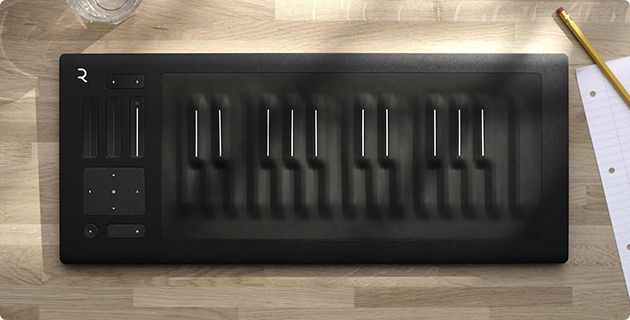Copy of MIDI Polyphonic Expression (MPE) Specification Adopted!

One of the biggest recent developments in MIDI is MIDI Polyphonic Expression (MPE). MPE is a method of using MIDI which enables multidimensional controllers to control multiple parameters of every note within
In normal MIDI, Channel-wide messages (such as Pitch Bend) are applied to all notes being played on a single MIDI Channel. In MPE, each note is assigned its own MIDI Channel so that those messages can be applied to each note individually.
The newly adopted MIDI Polyphonic Expression (MPE) specification is now available for download By MIDI Association members.
MIDI Manufacturers Association (MMA) Adopts New MIDI Polyphonic Expression (MPE) Enhancement to the MIDI Specification
Los Angeles, CA, January 28, 2018− Today marks the MIDI Manufacturers Association’s (MMA) ratification of a new extension to MIDI, MPE (MIDI Polyphonic Expression). MPE enables electronic instruments such as synthesizers to provide a level of expressiveness typically possible only with acoustic instruments.
Prior to MPE, expressive gestures on synthesizers—such as pitch bending or adding vibrato—affected all notes being played. With MPE, every note a musician plays can be articulated individually for much greater expressiveness.
In MPE, each note is assigned its own MIDI Channel, so that Channel-wide expression messages can be applied to each note individually. Music making products (such as the ROLI Seaboard, Moog’s Animoog, and Apple’s Logic) take advantage of this so that musicians can apply multiple dimensions of finger movement control: left and right, forward and back, downward pressure, and more.
MMA President Tom White notes that “The efforts of the members (companies) of MMA has resulted in a specification for Polyphonic Expression that provides for interoperability among products from different manufacturers, and benefits the entire music industry.”
Jean-Baptiste Thiebaut of ROLI concurs. “The MPE specification paves the way for a new generation of expressive controllers and music software, providing many creative opportunities for live musicians and producers. MPE remains fully compatible with MIDI.”
The MPE specification will be available for download in the coming weeks. To obtain a free copy, join the MIDI Association, the global community of people who work, play and create with MIDI, at www.MIDI.org.
MPE Press Release Downloadable PDF
The Basic Features of MPE
(Reprinted from the MIDI Manufacturers Association MPE Specification document’s Background Section)
(Note: not all devices may support all features)
The MPE specification aims to provide an agreed method for hardware and software manufacturers to communicate multidimensional control data between MIDI controllers, synthesizers, digital audio workstations, and other products, using the existing framework of MIDI 1.0.
These proposed conventions define a way of distributing polyphonic music over a group of MIDI Channels, making multiple parameters of different notes separately controllable. This will enable richer communication between increasingly expressive MIDI hardware and software.
Briefly, what is defined is as follows:
— Wherever possible, every sounding note is temporarily assigned its own MIDI Channel between its Note On and Note Off. This allows Control Change and Pitch Bend messages to be addressed to that particular note.
— A Registered Parameter Number is used to establish the range of Channels used for sending or receiving notes. Two messages control the division of MIDI Channel space into sub-spaces called
— When there are more active notes in a Zone than available Channels, two or more notes will have to share the same Channel. Under such circumstances, all notes will continue to sound, but will no longer be uniquely controllable.
— Each Zone has a dedicated extra Channel, called the Master Channel, which conveys common information including Program Change messages, pedal data, and overall Pitch Bend. These messages apply across the entire Zone.
(The MPE specification also defines how to handle Pitch Bend, Aftertouch and CC messages to provide maximum interoperability.)
The full MPE MIDI specification will be available soon for download in the Specs section of the site.
The following products support one or more of the features of MPE:
Digital audio workstations (DAWs)
- Bitwig 8-Track & Studio
- GarageBand macOS
- Logic Pro X
- Reaper
- Steinberg Cubase
- Steinberg Cubasis 2.6
- Tracktion Waveform
Software synthesizers
- Admiral Quality Poly-Ana
- Cycling ’74 Max
- Equator / Equator Player
- FXpansion Strobe2
- KV331 Audio SynthMaster
- Madrona Labs Aalto
- Madrona Labs Kaivo
- MainStage
- Native Instruments Reaktor
- Softube Modular
- Spitfire BT Phobos
- Stagecraft Addiction and Infinity
- Symbolic Sound Kyma
- UVI Falcon
- NOISE
- Seaboard 5D
- GeoShred
- GarageBand iOS
- Moog Model 15
- AniMoog
Hardware synthesizers
- Artiphon INSTRUMENT 1
- Audiothingies MicroMonsta
- Axoloti
- Deckard’s Dream
- Endorphin.es Shuttle Control
- Expert Sleepers FH-1
Futuresonus Parva- Haken Continuum
- MOD Duo
- Modal Electronics 001 / 002 / 002R
Modor NF-1 / NF-1mPolyend Poly- Snyderphonics MantaMate
These DAWs and synthesizer plugins can be used with certain MPE Controllers by following the setup guides provided by the MPE Controller maker:
- Ableton Live
- Audio Modeling SWAM Engine
- Digital Performer
- FL Studio
- iZotope Iris 2
- Native Instruments Kontakt
- Pro Tools
- Spectrasonics Omnisphere and Trillian
- Studio One
- U-he Diva
- Le Sound Reshape
MPE Live Chat
On May 26, 2018, we held the very first MIDI Live! chat with a panel of MPE specialists.
We recorded the session and it is presented here as a podcast.
Listeners were not only able to send in questions via text but were able to actually join the discussion and interact directly with the panelists. Roger Linn demoed his Linnstrument live from his studio in Los Altos.
DIscussions included the differences between the original MPE spec and the final MMA specification, MPE checklists, and test sequences, and the requirements for obtaining an MMA MPE logo that is under development.

MPE MIDI Live! Chat Podcast –
Here is a collection of Youtube videos showing off how expressive MPE enabled instruments can be.
Links to online MPE resources

Multidimensional Polyphonic Expression – Synthtopia

Bitwig | The Future of MIDI